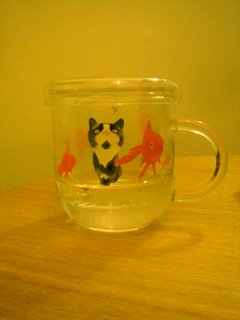
今年書展的best buy,包包盛惠20元,T-Shirt則40元。
王司馬的牛仔,Sempé的petit Nicolas,同樣可愛得令人愛不釋手。




 Stuart Haygarth, “Millenium Chandelier” (2004)
Stuart Haygarth, “Millenium Chandelier” (2004) Stuart Haygarth, “Tide Chandelier” (2004)
Stuart Haygarth, “Tide Chandelier” (2004)Caravaggio
Dick Bruna
Miffy
Tulip
Utrecht
Riddles??
謎底:
17世紀巴洛克時期意大利著名畫家Caravaggio影響力延伸至鬱金香國荷蘭,因為追隨者如Gerrit van Honthorst曾遊學羅馬,被這位意國大師那獨特的繪畫風格深深吸引,更讓他那強烈的光暗對比法移民至故鄉Utrecht。
Utrecht也是Miffy作者Dick Bruna先生的出生地,他至今仍居於此。
如今Utrecht有座聞名的博物館Centraal Museum,建於1838年,是荷蘭最古老的市立博物館,內設一個藝術展覽區,讓一衆兔迷認識Miffy的前世今生。
下次如果青兔失踪,可能會在Utrecht被補,因那裏有齊上述至愛。
還有, 小朋友別誤會Miffy是Hello Kitty或My Melody的親屬, 雖然Miffy和Melody都是兔 :-)




誠然,名建築師的家往往是最佳的作品示範,家居設計猶如芸芸傑作之縮影,盡現當事人對空間使用的獨門秘方,亦貫徹設計者深藏的理念。Paul Rudolph採用簡約至極的白,並採用開放式設計,拆掉界線與邊緣,使空間線條虛實交錯,亦力證現代設計看重multi-function與處理空間的靈活性。
然則功能便很易凌駕於形態,後者的「結局」全然取決於前者所能發揮的極限。這又好像將形態暗降為副車,狠狠將建築與美感脫鉤。
不過世事亦未可料。換個角度看,我們何不將功能看成帶領形態舞動的引子,釋放後者變幻的能量,讓其自由流動?以「有限」換「無限」,何嘗不是美麗的魔法?
一切皆取決於功能與形態的朝夕長短或是相輔相成。
** Thanks to Chad, we know that there is a lovely slideshow showing the renovated house Paul Rudolph did for himself on Beekman Place (courtesy New York Magazine) **

There is often something very "fishy" about Frank O. Gehry, who won the 1989 Pritzker Architecture Prize, the Oscar equivalent in Film. An architect in his own right, he was sometimes more like a sculptor. And now he is even marching bolding into the rivaling sand of "design". That is my first impression when I have recently bumped into his latest design for Tiffany, which is reminiscent of his most celebrated motif - fish.
 A devout believer of "architecture is art", Gehry openly admitted that artists like Brancusi had a more profound influence on his work than most architects. Perhaps that explains why most people find his architecture like a modernist sculpture. (By the way, I am completely thrilled by the fact that he also likes Alvar Aalto from the architecture world, for I am a big fan of this Finnish architect.) Gehry made a lot of “fish” in art as in architecture. Fish Dance (Kobe, Japan) is a prominent outdoor sculpture that by far overshadows the restaurant building itself.
A devout believer of "architecture is art", Gehry openly admitted that artists like Brancusi had a more profound influence on his work than most architects. Perhaps that explains why most people find his architecture like a modernist sculpture. (By the way, I am completely thrilled by the fact that he also likes Alvar Aalto from the architecture world, for I am a big fan of this Finnish architect.) Gehry made a lot of “fish” in art as in architecture. Fish Dance (Kobe, Japan) is a prominent outdoor sculpture that by far overshadows the restaurant building itself.
 Gehry's big fish is, on the other hand, functional in a most intriguing and ecstatic way. Take Barcelona Fish (Spain) for example. As a sculpture, his fish is too massive while as an architectural piece, it is too "fishy". I just wonder how he can accommodate the organic form to the geometric rules in the orthodox canon of architecture. No doubt that modern architects are rule-breakers, as much as the modern icon of the avant-garde in art. Loads of architects like Gehry and Zaha Hadid moved away from norms. They tested upon the limits of violating geometry.
Gehry's big fish is, on the other hand, functional in a most intriguing and ecstatic way. Take Barcelona Fish (Spain) for example. As a sculpture, his fish is too massive while as an architectural piece, it is too "fishy". I just wonder how he can accommodate the organic form to the geometric rules in the orthodox canon of architecture. No doubt that modern architects are rule-breakers, as much as the modern icon of the avant-garde in art. Loads of architects like Gehry and Zaha Hadid moved away from norms. They tested upon the limits of violating geometry.
 As Gehry states, "I approach each building as a sculptural object, a spatial container, a space with light and air, a response to context and appropriateness of feeling and spirit. To this container, this sculpture, the user brings his baggage, his program, and interacts with it to accommodate his needs. If he can't do that, I've failed."
As Gehry states, "I approach each building as a sculptural object, a spatial container, a space with light and air, a response to context and appropriateness of feeling and spirit. To this container, this sculpture, the user brings his baggage, his program, and interacts with it to accommodate his needs. If he can't do that, I've failed."
Recently, Gehry has been shifting from big to smaller fish. From Barcelona Fish and Fish Dance to his Fish Lamps, Pito Kettle for Alessi and Tiffany jewelries, I am not sure what's in the mind of this big big fish ;-)